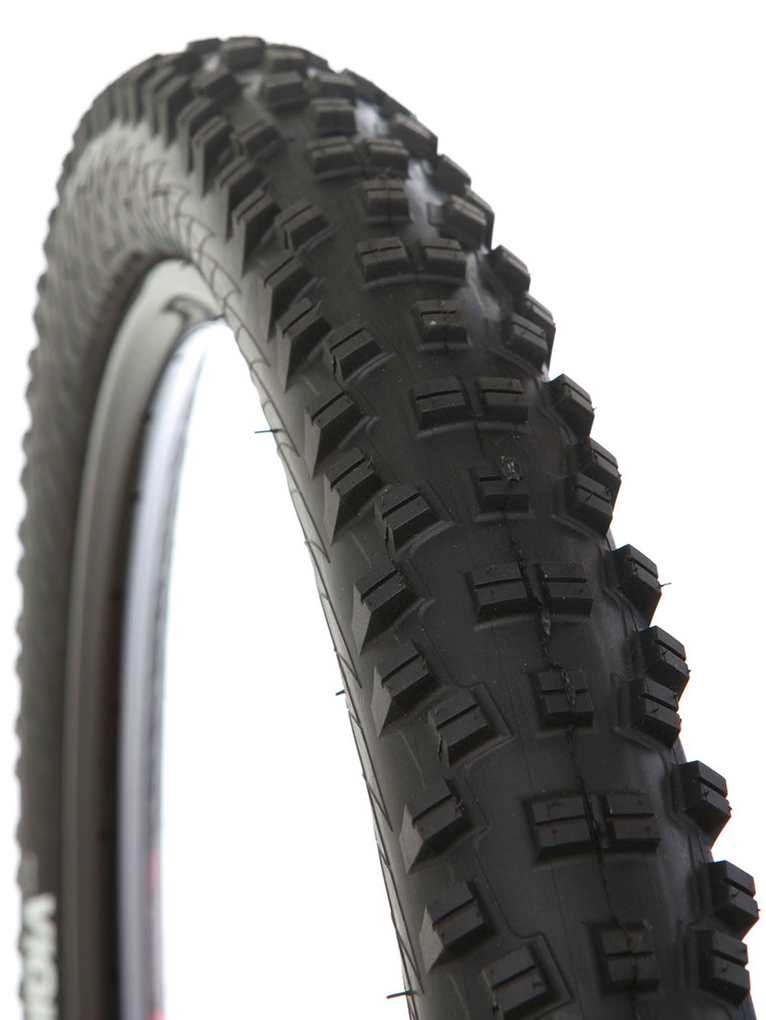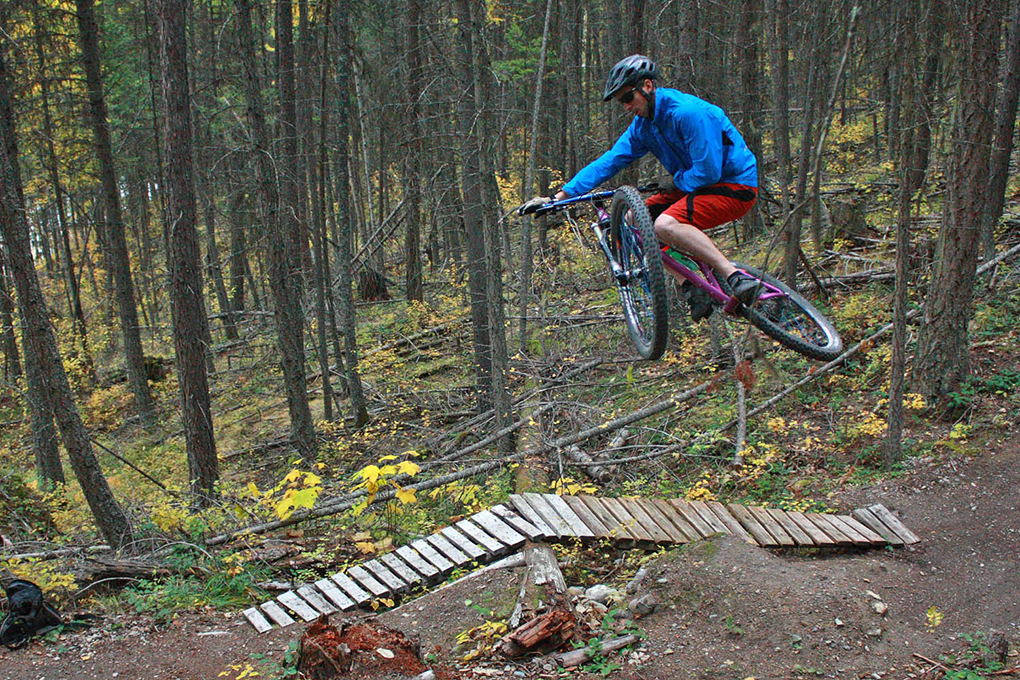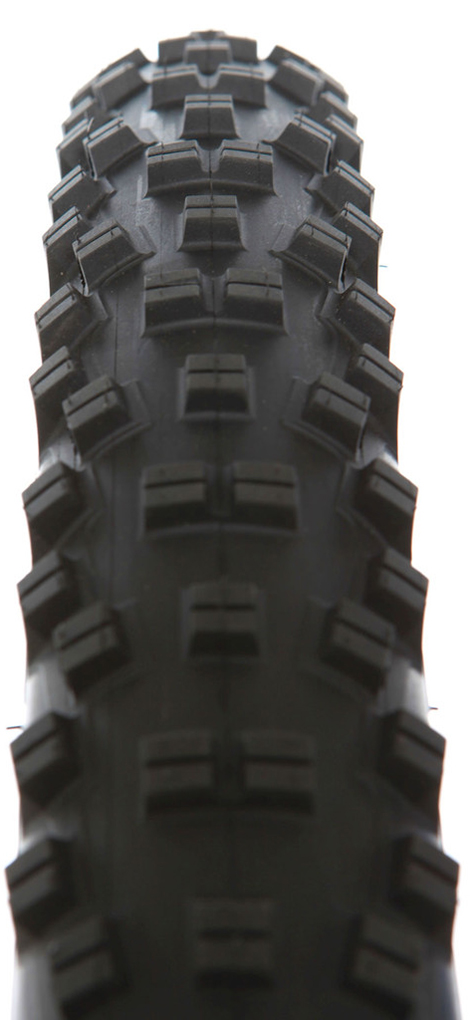
WTB Vigilante Tire
Stated Width: 29” x 2.3” (actual width on Stan’s Flow EX rims: 58mm / 2.28”)
Casing: Lightweight 60 tpi, TCS casing, folding bead
Measured Weight: 785 grams
Mounted to: Canfield Yelli Screamy, Stan’s Flow EX rims
Intended Use: All around knobby-ness
Duration of Test: 25 rides
Locations: Primarily in and around Whitefish, MT
Reviewer: 5’9” 150lbs
MSRP: $70
[Editor’s Note: We’ve tested two versions of the Vigilante, so this review covers both the 29” Vigilante with WTB’s standard “lightweight 60 tpi” casing, and the AM version of the same tire, with a reinforced casing.]
The Vigilante is a new offering from WTB, meant to fill in the enduro segment of their tire lineup. While I’m generally of the opinion that plastering “enduro” all over everything that was branded “all-mountain” three years ago is a waste of time, the Vigilante nevertheless has big blocky knobs, so I was at least interested in how it rides. In this respect, the Vigilante is a bit different from a lot of the other tires in WTB’s current lineup, many of which feature a high density of knobs in various shapes and heights, often with considerable buttressing. I generally tend to prefer tires that look more like the Vigilante, with an aggressive, relatively open knob pattern.
WTB has been making tires since Back to the Future’s present tense was still modern (1985 to be slightly more specific). I was a bit too young to appreciate the first iterations of WTB tires, but some of WTB’s earliest tire designs are still alive and kicking to this day. The Velociraptor was one of the first tires that found its way onto my bikes in the 90’s, and WTB still makes those tires to this day.
So WTB has been making tires for a long time, and they have a whole bunch of different tread patterns. But again, out of WTB’s newer offerings, the Vigilante looked the most like my cup of tea. I wanted something with aggressive tread that would hook up well in a corner.
I rode the 29” TCS (“Tubeless Compatible System”) version of the tire, which is the regular version. WTB also offers an “AM” version, which has additional material in the sidewall. This provides a bit more protection against torn sidewalls, but comes with a 100g weight penalty. I recently mounted up the AM version, so I’ll be reporting back on those in a month or two.
The TCS System
The Vigilante, as well as most of WTB’s other tires, are part of their TCS system. Basically this means that the WTB tires are made to work well with WTB rims, WTB rim tape, and WTB sealant. TCS components are still cross compatible with other brands (for instance, I was using the Vigilantes on Stan’s rims with Stan’s sealant and Stan’s tape), but there is some benefit to using TCS products together.
The TCS rims have a “bead lock,” a little nook that the bead of the tire wedges into, shaped to match the bead of TCS tires. Of course that means that the bead of the tire has to be the right size to fit snugly into that little nook. Once it’s in there, it creates a nice tight seal that resists popping out when you corner hard. This serves to minimize burping on hard hits and tight corners.
Does this whole bead lock thing sound vaguely familiar? If you’ve been shopping around for rims and tires, it should—it’s the same as Mavic’s UST system. And I don’t mean it’s just the same general idea; WTB’s TCS tires are actually UST certified, meaning they also fit the specs of Mavic’s UST system and will work nicely with any UST certified rim.
But to be clear, the TCS tires still need sealant—they aren’t a UST tire that can (theoretically) be run without sealant. This also means that the TCS tires weigh quite a bit less than a UST tire, since they don’t have the extra thick walls that enable sealant-less use.

Tubeless Set Up
As I mentioned previously, I actually used the Vigilantes on a Stan’s Flow EX rim that is neither TCS nor UST certified, and that doesn’t have any sort of bead lock or bead retention system. The Vigilantes set up tubeless with minimal hassle; a quick shot of Stan’s into the tire and I could easily get the bead to seat with a floor pump.
Since then, the Vigilantes have held air as well as any other tire I’ve tried—I only had to top them off once or twice in the two months that I used them.
Historically I’ve had a lot of problems with burping tubeless tires, which may be attributable in part to using Stan’s rims. That said, I had better luck with the Vigilantes than with any other tire I’ve used on Stan’s. I had one minor burp on a hard, off-camber landing, but other than that I didn’t have any issues keeping air in the tires.

The Tire Design
The Vigilante has a center row of square knobs that alternate from one wide to two wide. There’s minimal ramping on the knobs (both the leading and trailing edges are fairly sharp) and all of the knobs have a single lateral sipe. While the siping and sharp angles don’t make for the fastest rolling tire, the knobs do lend themselves to grinding up steep climbs and coming to a stop on a moment’s notice (more on that below).
The side knobs come in two flavors—on the outermost edge of the tire are pairs of knobs that are buttressed on their outside edge and siped laterally. Every third knob is inset, and depending on who you talk to, might be called a transitional knob.
(A Digression in Transitional Knobs)
On that note, let’s pause for a moment to discuss transitional knobs. Most tires have a row of center knobs. These are for all of the things you do while the bike is upright: traction when cranking up a loose climb, or traction when braking down a loose descent. Most tires also have a row of side knobs that help you keep your shit together in corners when the bike is leaned over.
Transitional knobs fall in between these two; they take up real estate in that section of the tire between the center knobs and side knobs. At first glance, these might seem great as they give you traction when you’re not fully upright, but not leaned all the way into a corner. So they might help you out in mild corners where you don’t need to lean the bike waaay over.
But it’s not quite that simple. While transitional knobs giveth, they also taketh away. The side knobs are at their most effective when they are getting shoved into the ground really really hard; that keeps them from breaking loose. When the bike is leaned way over and all of your weight is driving those side knobs into some loam, that’s the stuff dreams are made of.
But transitional knobs can ruin that fun. Transitional knobs placed just inboard of the side knobs effectively take weight off of the side knobs, which means the side knobs can’t dig in quite as hard, which means you can’t corner quite as hard. Depending on how exactly the knobs are placed, this can sometimes lead to fairly unpredictable cornering. Some tires that use transitional knobs, like the Kenda Nevegal, have a developed a minor reputation for offering great cornering performance at one moment that can quickly and unpredictably end at the next, leaving you washing out or collecting yourself on the outside corner of a the trail, wondering how you ended up on the ground so quickly. Long story short, minor weight shifts can make a big difference with tires that have lots of transitional knobs, and I attribute a lot of that to the transitional knobs’ placement.
But my bias is showing. Transitional knobs aren’t always bad. A tire without transitional knobs will generally have a defined channel between the center knobs and the side knobs (for example, see the 45 North Nicotine). When the bike is leaned over, as it crosses that channel, it will tend to drift. This can be disconcerting to those that aren’t used to it, and if nothing else, it means that the bike won’t really go around a corner properly unless it’s leaned way over. So transitional knobs can be really useful for hitting mild corners where high lean angles might not be necessary.

“The Vigilante doesn’t fare quite as well in soil with more gravel, where other tires do a better job of cutting through gravel and hooking up.”
Such as?
I ran these on Frequency i23s on my Tallboy LT for close to a year and beat the hell out of them with no issues and many happy miles. I was a little concerned when I upgraded to Enves but the fit has been just as solid … a marriage made in heaven to be sure. Agree with the (minor to me) weight and rolling trade-offs but that is a small price to pay for peace of mind.